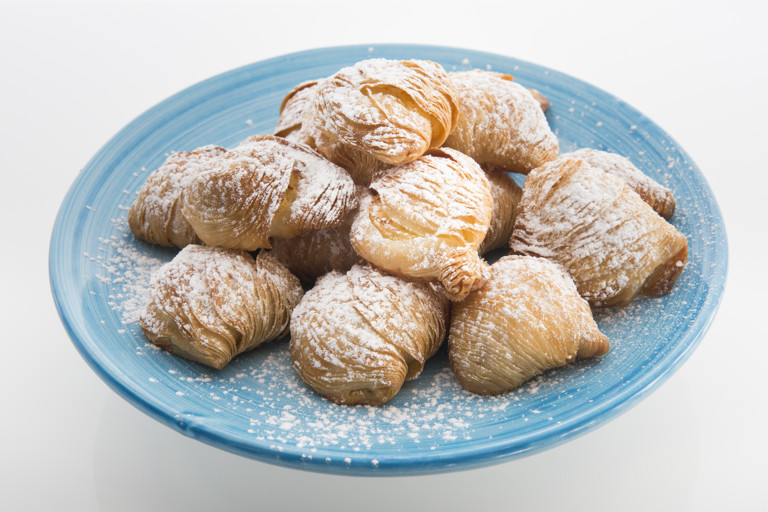Sfogliatelle
Item 1 of 1
- medium
- Makes 12
- 1 hour 30 minutes
Salvatore Elefante's traditional sfogliatelle recipe has the characteristic many-layered seashell shape and rich semolina and ricotta filling you'd expect of this classic Neapolitan pastry. These Italian pastries are often known as 'lobster tails' in reference to their shape, and require a little effort to roll and wrap the pastry into the beautifully thin and crisp layers. This recipe should make about 12 quite large pastries, but could make more if smaller – just keep an eye on them whilst baking as they may cook more quickly.
First published in 2016
discover more:
Ingredients
Metric
Imperial
Pastry
- 500g of plain flour
- 1 tsp salt
- 25g of honey
- 175ml of water
- 150g of lard, or butter, softened plus extra for greasing
- icing sugar, for dusting
SAVE RECIPE
Equipment
- Pasta machine
Method
1
To make the pastry, place the flour and salt in a large mixing bowl. Add the honey, then gradually mix in the water to create a stiff dough
- 500g of plain flour
- 1 tsp salt
- 25g of honey
- 175ml of water
2
Transfer to a clean work surface and knead the pastry for a few minutes until soft and pliable. Wrap in cling film and rest in the fridge for 30 minutes
3
Split the dough into 4 pieces to make it easier to roll out. Roll one piece of dough through a pasta machine as if making pasta – start by rolling at the widest setting, then folding in half and rolling again
4
Repeat twice more to create a smooth sheet, then start decreasing the width settings on the machine with each roll
5
When the sheet is very thin (approximately 1mm thick), lay it out on the work surface and spread over a thin layer of the softened lard or butter. Carefully roll up the sheet, starting from one of the short edges to create a tight sausage shape
- 150g of lard, or butter, softened plus extra for greasing
6
Repeat the process with the other pieces of dough, rolling each out to a thin sheet through the pasta machine and coating them with lard. Roll each of these around the original pastry sausage, building up the layers to create one large cylinder and stretching it out gently with each layer. Wrap tightly in cling film and chill for 1-2 hours to firm up
7
Meanwhile, make the filling by placing the milk, sugar and salt in a pan. Bring up to the boil, then whisk in the semolina flour until thickened and smooth. Transfer to a bowl to cool slightly, then beat in the remaining ingredients to create a smooth, thick cream. Transfer to the fridge and chill until needed
8
Preheat the oven to 180°C/gas mark 4. Line a baking tray with baking paper
9
Unwrap the pastry roll and use a sharp knife to cut it into 1cm thick slices. Using your fingers, gently flatten and push out the disc from the centre to form a shell or cone shape – greasing your fingers with a little more softened lard or butter can help
10
Scoop a spoonful of the ricotta filling into this hollow and gently press the pastry edges together. Repeat with the remaining pastry and filling, lining the filled pastries across the baking tray
11
Bake the pastries in the oven for about 25 minutes, or until golden brown and crisp. Allow to cool, then dust with a little icing sugar to serve
- icing sugar, for dusting
Get in touch
Please sign in or register to send a comment to Great British Chefs.




